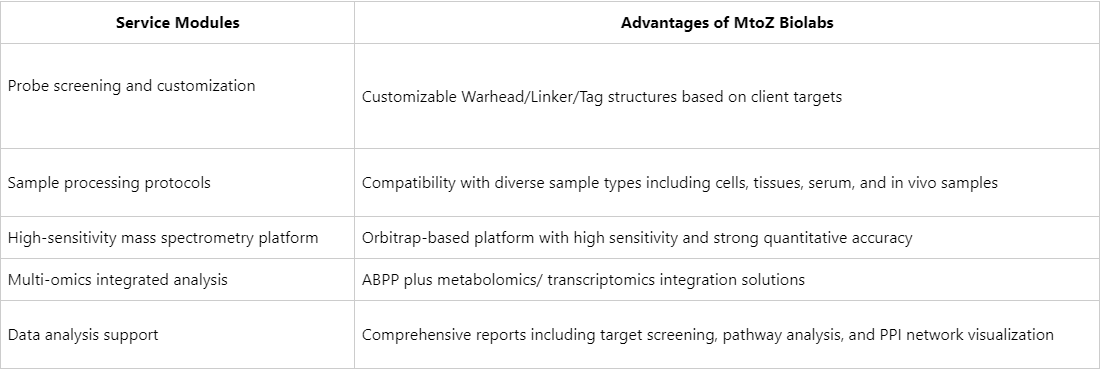How to Identify Active Enzyme Targets Using ABPP Technology?
Activity-Based Protein Profiling (ABPP) is a proteomic technique that enables the analysis of proteins based on their active sites. By covalently labeling functionally active proteins with specific small-molecule probes, ABPP allows for the efficient and accurate identification of catalytically active enzymes, providing a transformative tool for target discovery and elucidation of drug mechanisms.
Fundamental Principles of ABPP Technology for Active Enzyme Targets Identification
1. Definition of Active Enzyme Targets
An active enzyme target refers to an enzyme whose activity undergoes measurable changes under specific physiological or pathological conditions. For instance, a particular protease may exhibit markedly increased activity in cancerous tissues, suggesting its potential role in tumorigenesis. The identification of such enzyme targets not only facilitates a deeper understanding of disease mechanisms but also provides specific guidance for rational drug design.
2. Basic Principles of ABPP
The core of ABPP lies in the selective labeling of catalytically active enzymes by chemical probes. A typical ABP is composed of:
(1) Reactive group (Warhead): specifically recognizes the enzyme’s active site and forms a covalent bond with it.
(2) Linker: modulates the structural stability and spatial configuration of the probe.
(3) Tag: facilitates protein capture and detection, such as biotin, fluorescein, or alkynes.
When these probes are introduced into biological samples, ABPP can selectively capture enzymes that possess catalytic activity. Through enrichment, enzymatic digestion, and LC-MS/MS analysis, the specific active targets can then be precisely identified.
Detailed Experimental Workflow for ABPP-Based Enzyme Target Screening
Step 1: Sample Preparation and Probe Incubation
The designed ABP is added to cell lysates, tissue homogenates, or live-cell systems. The probe covalently binds to the active site of specific enzymes, thereby labeling only those enzymes in an active state. For studies investigating drug mechanisms, both a drug-treated group and an untreated control group should be established to enable subsequent identification of drug-inhibited targets.
Step 2: Protein Enrichment and Elution
The tag incorporated into the probe (e.g., biotin) enables selective capture of target proteins via affinity beads (e.g., streptavidin-coated beads). After multiple washing steps to remove non-specific background, the enriched sample predominantly contains catalytically active enzymes.
Step 3: Enzymatic Digestion and Mass Spectrometric Identification
Captured proteins are digested with trypsin (or LysC) and subsequently analyzed using a high-resolution LC-MS/MS platform. This enables precise identification of probe-bound peptides and the corresponding proteins. MtoZ Biolabs employs the Orbitrap Exploris 480 mass spectrometer, combined with optimized digestion and elution procedures, to detect thousands of functional enzyme targets from sample inputs as low as the microgram level.
Step 4: Quantitative Analysis and Target Selection
By comparing enzyme activity profiles between different experimental groups (e.g., drug-treated versus control), enzymes showing significant decreases in activity (i.e., inhibited enzymes) can be identified, suggesting their potential role as direct or indirect drug targets.
Advantages and Application Scenarios of ABPP in Target Identification
1. High Specificity
Selectively detecting enzymes that are catalytically active, ABPP excludes false-positive signals originating from inactive or non-catalytic enzymes.
2. Pre- and Post-Treatment Comparative Analysis
Enzyme activity profiles can be compared under conditions such as drug treatment or disease states, facilitating the identification of functionally relevant active targets.
3. Broad Applicability Across Enzyme Classes and Tissues
By choosing appropriate warheads, ABPP can be adapted to study various enzyme classes, including serine hydrolases, cysteine proteases, metalloproteinases, and protein tyrosine phosphatases.
Highlights of MtoZ Biolabs's ABPP Target Identification Services

In target discovery, validation of covalent drug mechanisms, and disease mechanism research, ABPP is not merely a method for detecting protein presence. It is a powerful approach for pinpointing the catalytically active functional units. Through rigorous experimental design, high-quality probes, and advanced mass spectrometry platforms, researchers can rapidly, accurately, and comprehensively identify potential active enzyme targets, laying a solid foundation for downstream functional validation and drug development. As a leading functional proteomics service provider, MtoZ Biolabs has established a comprehensive ABPP workflow encompassing probe design, sample preparation, high-resolution mass spectrometry, and target analysis, which has been widely applied in oncology, drug discovery, and immunometabolism research.
MtoZ Biolabs, an integrated chromatography and mass spectrometry (MS) services provider.
Related Services
How to order?







